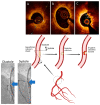Atherothrombosis in Acute Coronary Syndromes-From Mechanistic Insights to Targeted Therapies
- PMID: 33920201
- PMCID: PMC8070089
- DOI: 10.3390/cells10040865
Atherothrombosis in Acute Coronary Syndromes-From Mechanistic Insights to Targeted Therapies
Abstract
The atherothrombotic substrates for acute coronary syndromes (ACS) consist of plaque ruptures, erosions and calcified nodules, while the non-atherothrombotic etiologies, such as spontaneous coronary artery dissection, coronary artery spasm and coronary embolism are the rarer causes of ACS. The purpose of this comprehensive review is to (1) summarize the histopathologic insights into the atherothrombotic plaque subtypes in acute ACS from postmortem studies; (2) provide a brief overview of atherogenesis, while mainly focusing on the events that lead to plaque destabilization and disruption; (3) summarize mechanistic data from clinical studies that have used intravascular imaging, including high-resolution optical coherence tomography, to assess culprit plaque morphology and its underlying pathobiology, especially the newly described role of innate and adaptive immunity in ACS secondary to plaque erosion; (4) discuss the utility of intravascular imaging for effective treatment of patients presenting with ACS by percutaneous coronary intervention; and (5) discuss the opportunities that these mechanistic and imaging insights may provide for more individualized treatment of patients with ACS.
Keywords: acute coronary syndromes; calcified nodule; optical coherence tomography; percutaneous coronary intervention; plaque erosion; plaque rupture.
Conflict of interest statement
Madhavan is supported by an institutional grant by the National Heart, Lung, and Blood Institute of the US National Institutes of Health to Columbia University Irving Medical Center (T32 HL007854). The other authors declare no conflicts relevant to the content of this manuscript.
Figures




Similar articles
-
Optical Coherence Tomography in Acute Coronary Syndromes.Interv Cardiol Clin. 2021 Jul;10(3):323-332. doi: 10.1016/j.iccl.2021.03.004. Interv Cardiol Clin. 2021. PMID: 34053619 Review.
-
Utility of optical coherence tomography in acute coronary syndromes.Catheter Cardiovasc Interv. 2023 Jul;102(1):46-55. doi: 10.1002/ccd.30656. Epub 2023 May 28. Catheter Cardiovasc Interv. 2023. PMID: 37245076 Review.
-
Role of Intracoronary Imaging in Acute Coronary Syndromes.US Cardiol. 2022 Jun 23;16:e15. doi: 10.15420/usc.2022.03. eCollection 2022. US Cardiol. 2022. PMID: 39600836 Free PMC article. Review.
-
In vivo diagnosis of plaque erosion and calcified nodule in patients with acute coronary syndrome by intravascular optical coherence tomography.J Am Coll Cardiol. 2013 Nov 5;62(19):1748-58. doi: 10.1016/j.jacc.2013.05.071. Epub 2013 Jun 27. J Am Coll Cardiol. 2013. PMID: 23810884 Free PMC article.
-
Acute Coronary Syndromes: The Way Forward From Mechanisms to Precision Treatment.Circulation. 2017 Sep 19;136(12):1155-1166. doi: 10.1161/CIRCULATIONAHA.117.029870. Circulation. 2017. PMID: 28923905 Free PMC article. Review.
Cited by
-
Novel Biomarkers and Their Role in the Diagnosis and Prognosis of Acute Coronary Syndrome.Life (Basel). 2023 Sep 29;13(10):1992. doi: 10.3390/life13101992. Life (Basel). 2023. PMID: 37895374 Free PMC article. Review.
-
The role of NRF2 function and regulation in atherosclerosis: an update.Mol Cell Biochem. 2025 Jul;480(7):3935-3949. doi: 10.1007/s11010-025-05233-y. Epub 2025 Mar 1. Mol Cell Biochem. 2025. PMID: 40025257 Review.
-
Macrophage-based pathogenesis and theranostics of vulnerable plaques.Theranostics. 2025 Jan 2;15(4):1570-1588. doi: 10.7150/thno.105256. eCollection 2025. Theranostics. 2025. PMID: 39816684 Free PMC article. Review.
-
Identification and Management Strategies for Intracoronary High Thrombus Burden in Patients With STEMI: A Practical Experience and Literature Review.Rev Cardiovasc Med. 2025 Jul 30;26(7):37466. doi: 10.31083/RCM37466. eCollection 2025 Jul. Rev Cardiovasc Med. 2025. PMID: 40776951 Free PMC article. Review.
-
Acute Coronary Syndrome: Unravelling the Biology to Identify New Therapies.Cells. 2022 Dec 19;11(24):4136. doi: 10.3390/cells11244136. Cells. 2022. PMID: 36552899 Free PMC article.
References
-
- Stary H.C., Chandler A.B., Glagov S., Guyton J.R., Insull W., Jr., Rosenfeld M.E., Schaffer S.A., Schwartz C.J., Wagner W.D., Wissler R.W. A definition of initial, fatty streak, and intermediate lesions of atherosclerosis. A report from the Committee on Vascular Lesions of the Council on Arteriosclerosis, American Heart Association. Circulation. 1994;89:2462–2478. doi: 10.1161/01.CIR.89.5.2462. - DOI - PubMed
Publication types
MeSH terms
Grants and funding
LinkOut - more resources
Full Text Sources
Other Literature Sources
Medical

